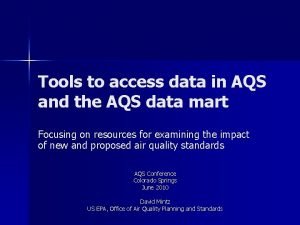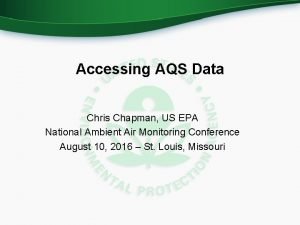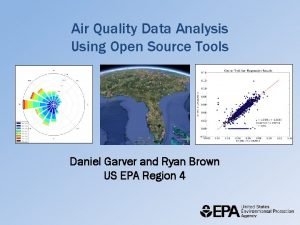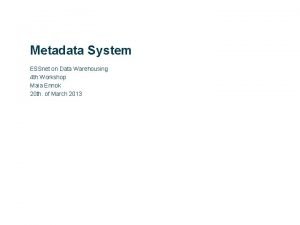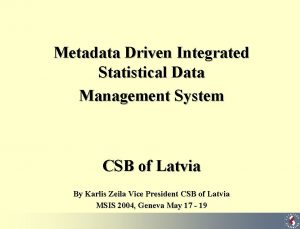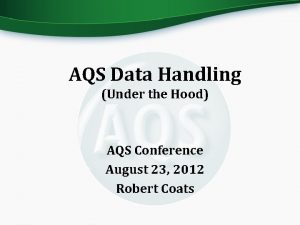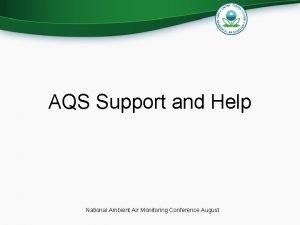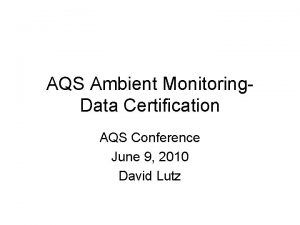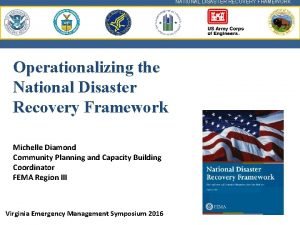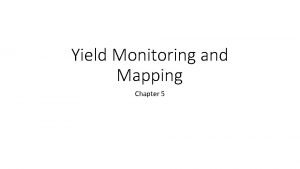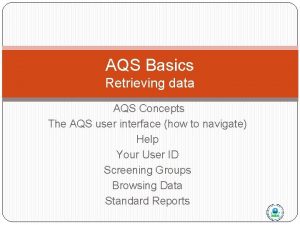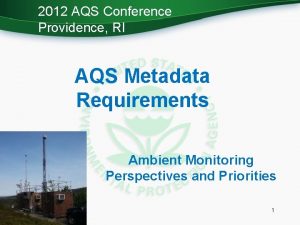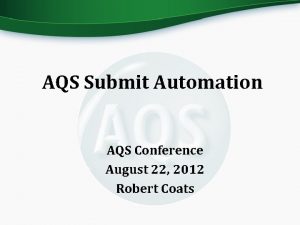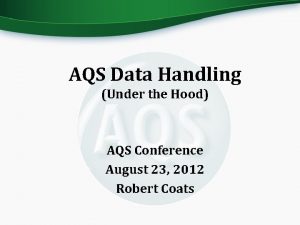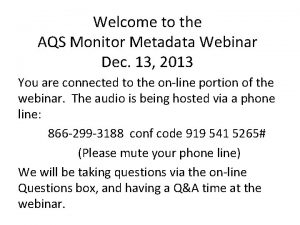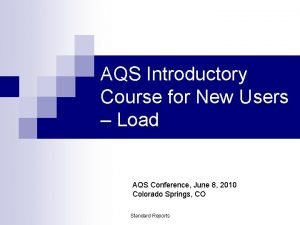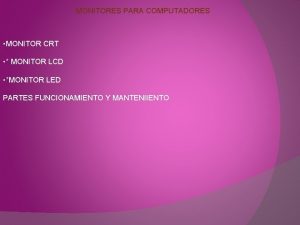AQS Monitor Metadata Data August 2016 AQS National
















- Slides: 16

AQS Monitor Metadata Data August 2016 AQS National Ambient Air Monitoring Conference August 2016 1

Types of Metadata (1) Site Basic Information Site Support Agency Site Tangent Roads Site Open Paths Primary Monitor Periods Site Samplers Sampler Channels Monitor Basic Information Monitor Sampling Period Monitor Type Monitor Agency Roles Monitor Objective AQS National Ambient Air Monitoring Conference 2016 2

Types of Metadata (2) Monitor Required Frequency & Schedule Monitor Tangent Roads Monitor Probe Obstruction Monitor Regulatory Compliance Monitor QA Collocation Monitor Method Monitor Network Affiliation Monitor Sampler Channel Monitor NAAQS Exclusion AQS Plans National Ambient Air Monitoring Conference 2016 3

Contents of Presentation This presentation will briefly discuss each of the types of Site and Monitor metadata – what it is, who is allowed to create or change it, and how to maintain it. A Tutorials is included for changing the primary monitor for a parameter AQS Plans National Ambient Air Monitoring Conference 2016 4

Basic Definitions A site is a geographic location (point) where ambient air quality monitoring occurs. A parameter is a measurable real-world quantity, such as a pollutant concentration or meteorological data. A sampler is a piece of real-world equipment for measuring one or more ambient air quality related parameters. A Monitor is an AQS abstraction of the equipment used to measure one parameter at a site. AQS Plans National Ambient Air Monitoring Conference 2016 5

Site Metadata (1) AQS Key: AQS sites are indexed by either of two methods – Tribal mode or State mode In Tribal mode, a site is uniquely identified by a Tribal Code and a Site Number In State mode, a site is uniquely identified by a State Code, County Code, and a Site Number All Sites are required to have a location – Latitude and Longitude All other geopolitical entities (e. g. Cities, CBSAs, & etc. ) are determined by this location. Owner: All sites are required to have an agency that is responsible for the site. Dates of operation (Date established, and date terminated) AQS Plans National Ambient Air Monitoring Conference 2016 6

Site Metadata (2) Support Agency: Agency other than site owner who is authorized to modify site metadata (optional) Tangent Road: Information about roads adjacent to site (optional) Open Path: Information for an open path (light beam) monitor. (optional) AQS Plans National Ambient Air Monitoring Conference 2016 7

Site-Parameter Metadata Primary Monitor Periods: This is the designation of a specific monitor as the primary one to be used for NAAQS determinations. It is required by 40 CFR Part 50 for certain criteria pollutants, but may be designated for any parameter. Note: This is different than QA collocation. However, when QA collocation is present, only the NAAQS primary may be the QA collocation primary. See Primary Monitor Tutorial for configuring and maintaining these. AQS Plans National Ambient Air Monitoring Conference 2016 8

Sampler Metadata AQS models samplers primarily support speciation analysis, where the filter from one sampler may be analyzed for many analytes (parameters). The AQS site-sampler record maps an AQS entity to a real world sampler or analyzer {Make, Model Number, and Serial Number} Each sampler has one or more channels for air flow through a filter. The monitors for each analytes for a channel are linked to the sampler and channel by the AQS Monitor-Channel entity. This allows flow audits and verifications to be submitted for a sampler and automatically applied to the appropriate monitors. Samplers are “owned” by a specific agency. See tutorial for setting up CSN Sampler. AQS Plans National Ambient Air Monitoring Conference 2016 9

Monitor Metadata (1) As noted above, monitors are associated with sampling one parameter at a site (and/or sampler) POC (Parameter Occurrence Code): This is an arbitrary number to allow multiple monitors at a site for the same parameter. AQS Assigns no meaning to POC. Monitors are “owned” by a specific agency. (Monitors are also owned by a “Screening Group”) Most of the fields associated with monitors are required to implement 40 CFR Part 58 and guidance. Sample Periods: The dates of operation of a monitor. Monitor Type: Administrative classification of a monitor. SLAMS is the primary monitor type for regulatory monitors. SPM (Special Purpose Monitor) is the primary type for criteria pollutant monitors not intended for regulatory use (e. g. non FRM/FEM method). Monitor Objective: Specifies the purpose of the monitor AQS Plans National Ambient Air Monitoring Conference 2016 10

Monitor Metadata (2) Monitor Method: Specifies the method of collection and analysis associated with a monitor. Monitor Exclusion: Specifies if data from the monitor should be excluded from NAAQS determinations. (optional) Requires Regional Concurrence. Note: Since SLAMS monitors are inherently Regulatory, a SLAMS monitor for a criteria pollutant may not be excluded. Probe Obstruction: If a real-world object is obstructing the air flow for a monitor, this should be documented via a probe obstruction record. (optional) Tangent Road: Allows distance to road to be recorded. (optional) Network Affiliation: National program that the monitor supports. (e. g. NCORE, PAMS, & etc, ) (optional) Regulatory Compliance: Deprecated (do not use) AQS Plans National Ambient Air Monitoring Conference 2016 11

Monitor Agency Roles 40 CFR Part 58 defines certain agency roles and responsibilities. AQS utilizes monitor agency roles to implement these. AQS also uses these roles to control access to monitor data by users assigned to the agencies. PQAO: Agency responsible for QA Reporting: Agency responsible for submitting data to AQS. Collecting: Agency that collects the samples. Analyzing: Agency (lab) that analyzes samples Certifying: Agency that certifies the data Audit: For the national Performance Evaluation programs (Part 58 Appendix A 2. 4), Agencies may be approved to “self implement” the program. AQS Plans National Ambient Air Monitoring Conference 2016 12

Required Collection Frequency Monitor Objective: Specifies the purpose of the monitor Some monitors are “intermittent” rather than “continuous”. These monitors are required to have a “Required Collection Frequency” to specify how often samples are collected. These monitors may have a collection frequency that varies by month (Sample Schedule) Note: There is a published calendar of “Scheduled Sampling Days” at https: //www 3. epa. gov/ttn/amtic/calendar. html When multiple samplers/monitor are utilized to achieve more frequent sampling the “Offset” is used to indicate if the monitor is sampling on the scheduled day or a certain number of days later. (See Composite Primary Tutorial) AQS Plans National Ambient Air Monitoring Conference 2016 13

QA Collocation 40 CFR Part 58 Appendix A requires PM and Lead monitor networks for a PQAO to have a certain percent of their monitors “collocated” in order to allow calculation of the precision and bias of the network. The purpose of a QA collocated monitor at a site is to assess the precision and bias of the primary monitor at the site. AQS requires both the (one) primary and the (one) QA collocated monitors to identified. As stated above, when the parameter requires a NAAQS primary to be identified, the QA primary must be the same as the NAAQS primary. AQS Plans National Ambient Air Monitoring Conference 2016 14

Example Changing the primary monitor for a PM 2. 5 site with QA Collocation. AQS Plans National Ambient Air Monitoring Conference 2016 15

Q&A Questions? AQS Plans National Ambient Air Monitoring Conference 2016 16
 Mxplorer
Mxplorer Aqs data mart
Aqs data mart Aqs data mart
Aqs data mart Api driven ddi
Api driven ddi Metadata layer data warehouse
Metadata layer data warehouse Metadata-driven data management
Metadata-driven data management Aqs chevrolet
Aqs chevrolet Aqs status
Aqs status Aqs in urdu
Aqs in urdu Aqs training
Aqs training Aqs training
Aqs training Aqs certification
Aqs certification 2016 national patient safety goals
2016 national patient safety goals Opsionel
Opsionel National disaster recovery framework 2016
National disaster recovery framework 2016 2016 national curriculum tests
2016 national curriculum tests Yield monitor data
Yield monitor data
